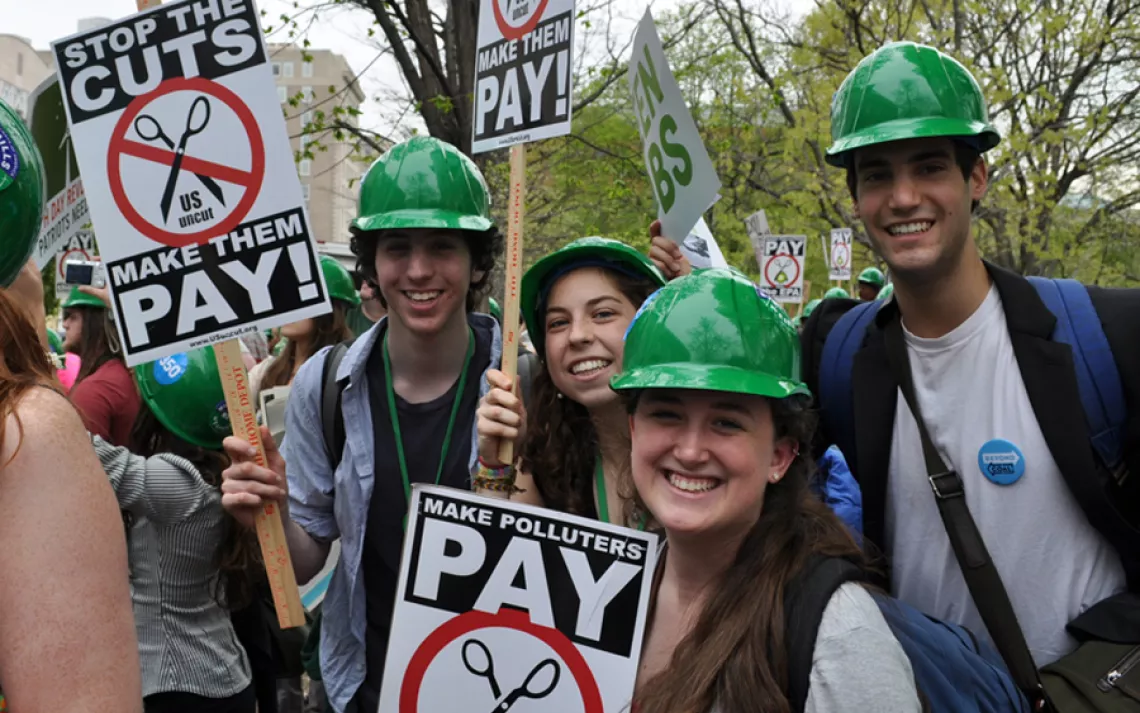Financial Statement
Universities divest from fossil fuel stocks—with varying degrees of commitment.
In May, Stanford University announced that it would divest from its stock in coal-mining companies. That set off celebrations among climate change activists, particularly members of Fossil Free Stanford, one of more than 400 student-led U.S. campaigns in an international movement to persuade institutional investors to divest from oil, gas, and coal stocks.
Universities are under particular scrutiny, since they’re most likely to be leading research on climate change and clean energy technology. “Stanford, on the edge of Silicon Valley, is at the forefront of the 21st-century economy,” climate activist Bill McKibben wrote in a statement after the university’s decision. “It’s fitting that they’ve chosen to cut their ties to the 18th-century technology of digging up black rocks and burning them.”
With its $18.7 billion endowment, Stanford is the wealthiest and most prominent of a dozen U.S. colleges that have divested from fossil fuels in some way since the grassroots climate organization 350.org (cofounded by McKibben) launched the Fossil Free movement in November 2012. As university president John Hennessy told Stanford News Service, “Stanford has a responsibility as a global citizen to promote sustainability for our planet, and we work intensively to do so through our research, our educational programs and our campus operations. The university’s review has concluded that coal is one of the most carbon-intensive methods of energy generation and that other sources can be readily substituted for it.”
Activists hope Stanford’s move will create a domino effect: Given time and momentum, the Fossil Free movement could be as successful as the apartheid-divestment efforts of the early 1980s, when at least 155 colleges partially or fully divested themselves of stocks linked to South Africa, helping pressure the country’s government to dismantle apartheid.
Despite the PR bonanza Stanford reaped, however, its divestment move was a carefully tuned and possibly painless decision.
Stanford picked “low-hanging fruit,” says Pitzer College trustee Donald Gould, the president of an asset management company and a champion of Pitzer’s recent decision to divest all fossil fuel stocks from its portfolio by the end of 2014. Stanford’s decision is narrow: The university will drop direct investments in about 100 companies involved in coal production, not the 200 fossil fuel extraction companies originally requested by Fossil Free Stanford. And its decision doesn’t affect investments in funds in which coal stocks are “commingled”—as with exchange-traded funds and mutual funds—though the university says that it will “recommend” that its external investment managers avoid investments in these funds. (Stanford does not divulge details of its investment portfolio, but Hennessy told the New Republic that between 1 and 10 percent of the school’s endowment is invested in fossil fuel stocks.)
The problem, Gould says, is that Stanford, like most universities, approached the divestment issue as both a financial and an ethical matter. In fact, Stanford’s Statement on Investment Responsibility, first adopted in 1971, affirms the trustees’ primary obligation to maximize financial returns—although when the trustees determine that “corporate policies or practices create substantial social injury,” they can factor it into their decision. “If you start with the question ‘What’s this going to cost?,’ it’s the wrong way,” Gould says. “You don’t have to view divestment from that standpoint. You can start by asking, ‘What’s best aligned with our values?’”
Pitzer also determined that its $125 million endowment wouldn’t suffer if it divested $5.4 million from fossil fuel stocks. It turns out, Gould says, that fossil fuel stocks perform about as well as other investments. That makes shuffling university assets less painful—though perhaps still complicated. He suspects that Stanford’s conservative focus on direct coal investments partly reflects the complexity of untangling commingled funds. For the same reason, Pitzer chose to “substantially” divest from its fossil fuel stocks rather than commit to ferreting out every last fossil fuel–tainted fund. (“You don’t need to take things literally,” Gould says.) Nevertheless, Pitzer expects to be 99 percent free of fossil fuel stock by the end of the year.
As it turns out, even pure bottom-line investors may eventually rethink coal. Thanks to declining U.S. consumption and increased regulation of carbon-based fuels, coal stocks are on shaky ground. (See “Falling Stock,” page 38.) Once carbon regulations ramp up—perhaps pushed along by the divestment decisions of universities—fossil fuel companies could be left with share-plummeting “stranded assets”: resources left in the ground, exactly where the Fossil Free campaigns want them to stay. A University of Oxford report on divestment campaigns against tobacco, apartheid, armaments, gambling, and pornography found that every one of them had also successfully led to restrictive legislation.
Stanford says that it limited its decision to coal stocks partly to avoid charges of ivory tower posturing. “It would have been viewed as hypocritical to say, ‘You should divest from fossil fuels,’ when everyone on this campus consumes fossil fuels,” Stanford’s Hennessy told the New Republic. Since California relies on coal for only 7.5 percent of its energy—less than half the state’s share of renewable energy—moving against coal hardly causes ripples. But Pitzer’s Gould thinks that worries of hypocrisy are exaggerated. “We’re embedded in a fossil fuel economy,” he says. “I don’t see hypocrisy in selling your oil stock while still filling your gas tank.”
Other critics, of course, argue that Stanford and Pitzer are wrong. They reason that any university fossil fuel divestment is just feel-good symbolism, since neither coal company stock prices nor global coal consumption will drop as a result. That argument, along with fears that endowment value will decline, has been a standard defense of university administrators at Swarthmore, Brown, Middlebury, and—most notably—Harvard. “The endowment is a resource, not an instrument to impel social or political change,” Harvard president Drew Gilpin Faust wrote in a statement last fall as on-campus climate actions heated up over the impact and future of the school’s $32.7 billion endowment. “If we and others were to sell our shares, those shares would no doubt find other willing buyers.”
But that outlook considers only divestment’s immediate financial effect and not the cultural and public policy clout that Harvard or Stanford wields. In the long term, “stigmatization poses a far-reaching threat to fossil fuel companies,” says Ben Caldecott, a program director at the University of Oxford’s Smith School of Enterprise and the Environment and an author of Oxford’s divestment report. “Any direct impacts of divestment pale in comparison.”
Even Stanford is missing an opportunity to capitalize on its high-profile divestment move, refusing interviews and referring reporters to its published announcement. “We are not leading a charge,” insists Susan Weinstein, Stanford’s assistant vice president for business development and chair of the school’s Advisory Panel on Investment Responsibility and Licensing, which brought the divestment proposal to the board of trustees. “Every university needs to make its own decision.”
“That upsets me,” says Yari Greaney, an organizer of Fossil Free Stanford. “We wish Stanford would share information with other institutions.” Greaney’s group was delighted that the university moved quickly on coal, but will continue to push for its broader goals. Says Greaney: “Divesting coal stocks is a great step, but a small step.”
This story was funded by the Sierra Club’s Beyond Coal campaign.
What Do We Want? Clean Energy.
Through efforts like the Sierra Student Coalition’s Campuses Beyond Coal campaign (sc.org/CampusesBeyondCoal), student activists have helped retire a third of the nation’s on-campus coal plants since 2009. And for several years, students have rallied behind the banner of the Fossil Free movement (gofossilfree.org), urging their universities to divest from stock in fossil fuel companies, along the way notching a dozen successes.
But what do climate-conscious students want to replace fossil fuels? The answer is blowing in the wind (and shining in the sky). Through the Sierra Student Coalition’s just-launched Campuses for Clean Energy Campaign (sc.org/CfCEnergy), student activists will work to persuade universities across the country to demand 100 percent clean energy on campus—solar and wind, primarily—from their energy utilities. “Unlike divestment,” says Indiana University grad student Kathleen de Onis, “This is reinvestment.”
Universities are major, high-profile energy consumers with the kind of moral and economic clout that an individual utility customer can’t muster. Still, de Onis concedes that convincing a university bureaucracy to take on a utility bureaucracy can take years—often longer than the four-year commitments of most college students. So Indiana activists are considering pursuing more immediate solutions as well, like applying for grants to install solar panels on campus.
“For students who don’t have solar energy in their home communities, this is a great way to help change attitudes and behavior around energy use,” she says. “Universities are designed for the exchange of ideas. If it can’t happen at a university, then it’s difficult to imagine it happening elsewhere.”
 The Magazine of The Sierra Club
The Magazine of The Sierra Club





